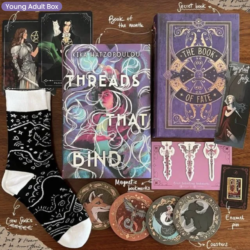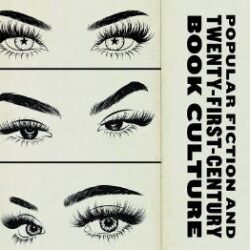Earlier this year I wrote a piece for SHARP news on the new Penguin Books Vending Machine at Exeter Railway Station, including other Penguin initiatives around selling books. Bookending what has been a bumper year for this topic, earlier last month a spectacular Christmas tree was unveiled at St Pancras Station, a collaboration between Penguin and Hatchards. This “magical reading experience”, an “ode to the wealth of literature that transports us to exciting and novel worlds”, situated in one of London’s busiest stations, is 12 metres high, and has 270 shelves with over 3800 hand-painted books.
The Made-Collectible: The Bookish Iconography of the Franklin Library and FairyLoot
No matter the time or place, the ownership of books has functioned not only as a point of access to texts, but also as a status symbol. There are many ways books can convey that status, including their material characteristics as determined by their makers. A revealing case study of this principle is the rise of FairyLoot, a subscription-based publisher of “exclusive editions,” and how it relates to earlier subscription based “made-collectible” models, like that of the Franklin Library. In short, companies like FairyLoot are this generation’s version of the Franklin Library. The same marketplace principles apply—but because the audience is different, the end result of the manufactured object also differs. What brings these seemingly disparate companies together is their shared strategy of creating books with physical attributes that read to their target audience as “collectible.”
James W. Watts and Yohan Yoo (eds.). Books as Bodies and as Sacred Beings.
The volume, edited by James W. Watts and Yohan Hoo, is a thought-provoking addition to our discipline as it expands the study on sacred texts by looking at them attaining the status of bodies, as well as body practices that merge with the materiality and immateriality of texts. Watts is a professor of religion who has focused on the rituals that surround scriptures. Many of the chapters are grounded on the three dimensions of sacred texts proposed by Watts himself: semantic, expressive or performative, and iconic. The first one refers to textual interpretation; the second to how a text gets materialized through the body by being read, memorized, sung or acted; while the last one refers to the material form and visual appearance of a text.
Simon Rowberry. Four Shades of Gray: The Amazon Kindle Platform.
Users of hardware such as the Kindle tend to have a preferred format, sometimes refusing to replace the device until it has completely gone beyond the point of use. This is just one of the phenomena that Simon Peter Rowberry hits on in his book Four Shades of Gray: The Amazon Kindle Platform (a nod to the greyscale used in the first Kindle back in 2007) as he delves into the inner workings of the Kindle, both as a platform and a larger tool in the Amazon ecosystem. This work balances the line in giving the reader valuable technical information, but remaining readable to most of the scholars, students, and publishers who will find merit in this book.
Kim Wilkins, Beth Driscoll, and Lisa Fletcher. Genre Worlds: Popular Fiction and Twenty-First-Century Book Culture.
In 2017, I reviewed Jeremy Rosen’s exploration of genre and late 20th/21st century publishing in Minor Characters Have Their Day for SHARP News. So it seems only fitting that 5 years later I have the opportunity to review Genre Worlds: Popular Fiction and Twenty-First-Century Book Culture by Kim Wilkins, Beth Driscoll, and Lisa Fletcher. Genre Worlds is a more expansive examination of genre in popular fiction than the work of Rosen and many others, and provides an important framework for the study of genre fiction. Genre Worlds follows an organizational structure that addresses the theory of genre worlds, relationship to the publishing industry, transnational and transmedia genre worlds, community and creativity, genre sociality (online and in-person), the texts themselves, concluding with genre worlds and change.





